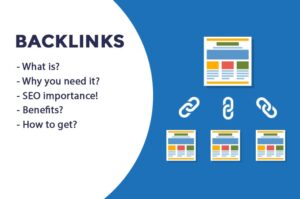
Many have been trying to understand the term backlinks hence so many start up bloggers and website owners happen to be finding it difficult to understand the term or know what it really is as well as the benefits it brings to your website or blog and that’s what prompted the writing of this article today. In todays article, i will explaining what Backlinks is and how you can build backlinks for your blog or website.
What are Backlinks?
Backlinks are links that are embedded on other websites or blogs you happen to either do a guest post or review post on, and these links happen to point back to your website or other websites that are being optimized.
Moreover, backlinks happen to be inbound links with pure understanding it is a link that connects to a post, page, website or blog. It is an essential part in site navigation before the presence of search engines and with the presence of search engines as well.
Furthermore, the total number of backlinks or websites linking to your blog is an indication of how popular your blog or website is and search engines use this info to rank your blog among the top blogs when presenting search results to visitors and researchers, Meanwhile, the origin of the backlink is related to quality content, quality blogs, and no way from spam websites that’s how its gets counted.
What are the benefits of having a backlink?
Well in real terms the functionality and benefits of backlinks are essential to increase the level of your website or blog in search engines. i.e it increases your page ranking in google and other search engines search results this will thus make you blog or website appear at almost every search made by a visitor with related keywords to your blog or website content. However, it can also increase the popularity of your blog as well as raise page rank.
The following benefits comes with having a backlink:
- Increase the page rank of the website.
- Improve the quality of SEO and SERP.
- Increase visitor numbers.
Also Check: How To Create and Manage a Successful Youtube Channel
General Terms For Backlinks
We will be highlighting some of the most terms relating to backlinks below and their meaning.
> Juice Link: This is when a web page links to an article or homepage of your blog or is often referred to as an inbound link. This link juice can help improve article ranking and popularity and increase domain authority.
> Nofollow Links: In this case, when a blog or website link (connects) to another website but the link has a no-follow tag then this url link is not considered a juiced link. However, the webmaster uses no-follow tags when they connects to irrelevant sites. For instance, a url link from a comment on another blog.
> Dofollow Links: All the links you embed in a blog article or post are regarded as do-follow urls and this will pass the juiced link.
> Internal Links: These happen to be links between related posts and article in your blog or website. These links are called internal links. For instance, is when you link your articles to another article with similar topic on your blog (Same Domain).
> Low-Quality Links: Low-quality links are links that come from automated sites, such as spam sites, or porn sites. in this case, these links do far more harm to your blog than it does good. By wall means we recommend you avoid such backlinks, and thus be careful when buying backlinks from untrusted sites, you should be certain of the kind of site.
> Linking Root Domain: This simply refers to the number of backlinks url that go to your website from a unique primary domain name. for instance, if in any way a blog has initially initiated a link to your website/blog, ten (10) times then it will be regarded as a link from a single root domain.
> Anchor Text: Any text used for hyperlinks is regarded as anchor text. However, backlinks with anchor text work as you try to optimize for better search results with specific keywords.
Nevertheless, there are several ways to build backlinks, one of them includes the use of White Hat. These is usually like BlogWalking, Swapping of Links, Comment etc.
What is the Difference between External Links and Internal Links?
1. External links (Backlinks)
It is a link or links that leads to another blogs domain or content within the domain. According to SEO experts who says that external linking is a very important method in helping a website get page rank power.
Furthermore, external links have a different “Juice Link” than internal links because search engines, like Google and others happen to regard it as a recommendation from others to believe that the link is relevant.
2. Internal Link
An internal Link is a hyperlink that points to the same domain as the domain that is on the link (source). i.e, it is an internal link linking to another page on the same blog.
No doubt, internal links are also influential for SEO efforts, such as it helps to navigate search engines and analyze your blog to determine the number of pages you have and also by always linking interconnected content into website articles or web pages within a domain it tells search shows of the availability of that article in your blog whenever a researcher or visitor happen to key in related keywords of that article.
How To Build and get Backlinks
Just as it is mandatory a blog or websites gets as much backlinks as it can possibly can as this raises its page ranks in search engines. in other to build backlinks they are several steps you could possible try out which i highly recommend.
1. Guest posting: As a writer and a blog owner, you can reach out to other blog owners and offer to write for them, while doing so, you can be sure to leave a trace link back to your original domain or blog as the source of the article. that way when readers happen to stumble on the article and it entirely interesting, they would want to hear and read more articles from author that way they might happen to follow you back to your blog through the trace link you left behind. this method not only gets you backlinks but traffic as well.
2. Comment link: In this case you can leave a comment writers articles, a heart felt comment commending the writer and if you happen to have similar topic article in your blog, you can embed it along side the comment before posting.
3. Swapping backlinks: Now you can reach out to your fellow bloggers and discuss the swapping of backlinks. that is you tell them to allow you write and publish a post in their blogs relating to their niche and yours and in the post you leave your link then you in turn will also allow them to publish an article on your blog and while doing so, they can also leave a trace link back to their blog on the article.
Here that’s all on what you need to know about backlinks, types of backlinks, difference between backlinks and how to build and get backlinks. If you find this article helpful to you, please kindly like and leave a heart felt comment down below in the commentary section. also if you happen to have other suggestions regarding the building of backlinks you might want to add feel free to comment it below.
Again, do remember to share this article with your friends and bloggers to help them out too. you can subscribe to our blog by entering your email on the subscription box below or by clicking on the bell icon to get the latest news and updates from us as we publish them. Our online community platforms are open to everyone who intends to get the latest gist and trends as they unfolds.
This article was originally published on SmartcoreTech and backlinked here on thescoove.africa by the author all rights received for more updates and post on blogging as well as news visit https://www.smarttechvilla.com









